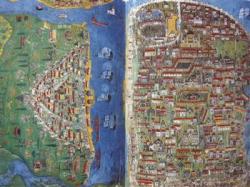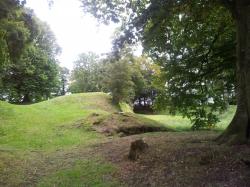INSTITUT SUPERIEUR D'ANTHROPOLOGIE
INSTITUTE OF ANTHROPOLOGY
ONLINE COURSES / COURS A DISTANCE
SPRING TERM : APRIL 2014
REGISTER NOW
CHINE –  Chongqing - China's first underwater archaeological research ship, China Archaeology 01, is to be launched in Chongqing on Friday.The five-story ship measures 56 meters in length and has 11 rooms. Before conducting its operation in the Nansha Islands, the ship will be loaded with necessities in Nanjing, the capital city of east China's Jiangsu Province; it will then set off on its trial course in Shanghai. The ship is equipped with professional equipment that enables archaeologists to find and position the relics underwater, to map and record, and to conduct timely protection work.
Chongqing - China's first underwater archaeological research ship, China Archaeology 01, is to be launched in Chongqing on Friday.The five-story ship measures 56 meters in length and has 11 rooms. Before conducting its operation in the Nansha Islands, the ship will be loaded with necessities in Nanjing, the capital city of east China's Jiangsu Province; it will then set off on its trial course in Shanghai. The ship is equipped with professional equipment that enables archaeologists to find and position the relics underwater, to map and record, and to conduct timely protection work.
http://english.cri.cn/6909/2014/01/24/2281s809776.htm
PAKISTAN –  Multan -Seventy per cent work on the conservation and restoration of two gates of the 180-year-old Satgarah Fort in Okara has been completed, an Archaeology Department official said on Thursday.The fort, built by Maharaja Ranjeet Singh in 1830, has three watch towers. The tomb of Mir Chakar Khan Rind is located at the fourth corner. The officials said that the tomb was built over four centuries ago and had pre-existed.
Multan -Seventy per cent work on the conservation and restoration of two gates of the 180-year-old Satgarah Fort in Okara has been completed, an Archaeology Department official said on Thursday.The fort, built by Maharaja Ranjeet Singh in 1830, has three watch towers. The tomb of Mir Chakar Khan Rind is located at the fourth corner. The officials said that the tomb was built over four centuries ago and had pre-existed.
http://tribune.com.pk/story/662626/conserving-history-restoration-of-satgarah-forts-two-gates-nears-completion/
TURQUIE -  -UNESCO has added a 16th-century Ottoman swordsman to its 2014 agenda to commemorate him on the 450th year of his death. Matrakçı Nasuh is described as one of the most swordsmen in history. Turkish historian Erhan Afyoncu has described Nasuh as a Hazerfen, a person with vast knowledge over various subjects. Afyoncu noted “His most important skill is swordsmanship. He traveled to Egypt and participated in games. After beating all his opponents, he was praised by Egyptian rulers.” Nasuh also received an imperial order from Sultan Suleiman the Magnificent for his sword skills. His title Matrakçı is derived from a sword game, Matrak. A historic form of swordplay to assist with training soldiers during peaceful times. It includes a long wood stick and fence and the aim is to hit the opponent first. “Nasuh was the master of that game,” Afyoncu said. Other than Matrak, he was known for his art miniatures. He created a style that focused on panoramic views of landscapes and cities painted with great detail. He miniaturized buildings, places of worship, surroundings and places where the Ottoman army rested. Nasuh of Bosnian descent wrote books on mathematics. Afyoncu said, “Those books included formulas to help bureaucrats with the treasury.” He said that Nasuh wrote many books, some recently discovered they actually belong to Nasuh himself. He died in 1564.
-UNESCO has added a 16th-century Ottoman swordsman to its 2014 agenda to commemorate him on the 450th year of his death. Matrakçı Nasuh is described as one of the most swordsmen in history. Turkish historian Erhan Afyoncu has described Nasuh as a Hazerfen, a person with vast knowledge over various subjects. Afyoncu noted “His most important skill is swordsmanship. He traveled to Egypt and participated in games. After beating all his opponents, he was praised by Egyptian rulers.” Nasuh also received an imperial order from Sultan Suleiman the Magnificent for his sword skills. His title Matrakçı is derived from a sword game, Matrak. A historic form of swordplay to assist with training soldiers during peaceful times. It includes a long wood stick and fence and the aim is to hit the opponent first. “Nasuh was the master of that game,” Afyoncu said. Other than Matrak, he was known for his art miniatures. He created a style that focused on panoramic views of landscapes and cities painted with great detail. He miniaturized buildings, places of worship, surroundings and places where the Ottoman army rested. Nasuh of Bosnian descent wrote books on mathematics. Afyoncu said, “Those books included formulas to help bureaucrats with the treasury.” He said that Nasuh wrote many books, some recently discovered they actually belong to Nasuh himself. He died in 1564.
http://www.hurriyetdailynews.com/ottoman-master-matrakci-nasuh-to-be-commemorated-by-unesco.aspx?pageID=238&nID=61411&NewsCatID=375
ROYAUME UNI -  Tullaghoge Fort - “Tullaghoge is probably the premier archaeological site in Ulster,” said Brian Sloan from the Centre of Archaeological Fieldwork (CAF) from Queen’s University Belfast. “We have found this site to be very clean so far which suggests it may have been used for cattle. However, we did discover some prehistoric remains near the stream. The flint piece was used to scrape fat from animal skins to make them more malleable, probably during the Bronze Age (around 2000BC). “We haven’t come across any medieval artefacts - the time of Hugh O’Neill - as yet. Perhaps that means that the human focus was always up on the monument.” Brian suggested that the site beside the river may have been in continual use from the prehistoric era right through the inhabitation of the O’Neills to when Robert Lindesay was granted the land in 1611. “Where it is situated beside the river could mean that it would have been the focus of Bronze Age people. You’ve got to remember that to them, the stream was like a motorway. It would have been easy to launch a little canoe here. “In the trenches you’ve got a build-up of ploughsoil which is evidence of the place having been cultivated over many hundreds of years. But as we go further down we have come across a stone layer and it is just regular stones, compacted in and from that is where we found the little flint scrapper. “It may be that this suggests a Bronze Age horizon, but we will know more once we get it completely cleaned back. Archaeology is, unfortunately, a very destructive process and that’s why we would try and keep the trenches nice and small. So we are trying to have a little keyhole look into these features.” The site first came to historical prominence in the 11th century when it was a dynastic centre and inauguration place of the Cenél nEógain (later the O’Neills). It was the residence of the O’Hagans who, with the O’Cahans, performed the inauguration ceremony. The Lindesays are known to have subsequently lived in the two-story English-style house which had been built up on the rath by the Gaelic inhabitants. However, they later moved across the river to the Loughry Estate.
Tullaghoge Fort - “Tullaghoge is probably the premier archaeological site in Ulster,” said Brian Sloan from the Centre of Archaeological Fieldwork (CAF) from Queen’s University Belfast. “We have found this site to be very clean so far which suggests it may have been used for cattle. However, we did discover some prehistoric remains near the stream. The flint piece was used to scrape fat from animal skins to make them more malleable, probably during the Bronze Age (around 2000BC). “We haven’t come across any medieval artefacts - the time of Hugh O’Neill - as yet. Perhaps that means that the human focus was always up on the monument.” Brian suggested that the site beside the river may have been in continual use from the prehistoric era right through the inhabitation of the O’Neills to when Robert Lindesay was granted the land in 1611. “Where it is situated beside the river could mean that it would have been the focus of Bronze Age people. You’ve got to remember that to them, the stream was like a motorway. It would have been easy to launch a little canoe here. “In the trenches you’ve got a build-up of ploughsoil which is evidence of the place having been cultivated over many hundreds of years. But as we go further down we have come across a stone layer and it is just regular stones, compacted in and from that is where we found the little flint scrapper. “It may be that this suggests a Bronze Age horizon, but we will know more once we get it completely cleaned back. Archaeology is, unfortunately, a very destructive process and that’s why we would try and keep the trenches nice and small. So we are trying to have a little keyhole look into these features.” The site first came to historical prominence in the 11th century when it was a dynastic centre and inauguration place of the Cenél nEógain (later the O’Neills). It was the residence of the O’Hagans who, with the O’Cahans, performed the inauguration ceremony. The Lindesays are known to have subsequently lived in the two-story English-style house which had been built up on the rath by the Gaelic inhabitants. However, they later moved across the river to the Loughry Estate.
http://www.midulstermail.co.uk/what-s-on/arts-culture/video-evidence-of-bronze-age-life-at-tullaghoge-fort-1-5822801